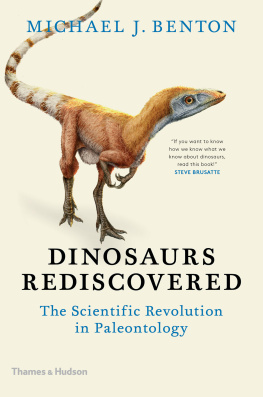To Mary, Philippa and Donald
for their forbearance and inspiration, as ever
ACKNOWLEDGMENTS
In this new edition, I am grateful again to Colin Ridler of Thames & Hudson for managing the process, and for his encouragement throughout. Fifteen years ago, he first suggested that I should write this book, and then he discreetly guided me through various false starts. Thanks to him, and to his team, for their thorough and extensive work on the book as it went through the publication process. The entire text of the first edition was read by Paul Pearson and Richard Twitchett at the University of Bristol, James Lovelock at the University of Oxford, and Paul Wignall at the University of Leeds. I value the time they spent reading the draft manuscript, their wise suggestions about style and content, but especially for picking up some glaring misunderstandings and errors of fact. Thanks also to archivists and librarians at the Geological Society of London, the British Library and the Natural History Museum, for finding ancient letters and notebooks by Murchison, Owen and the others. Finally, the appearance of the book has been enhanced immeasurably by the artwork, and I thank John Sibbick for his exquisite craftsmanship informed by a real knowledge of the ancient beasts he draws.
CONTENTS

When I was a student of palaeontology in the late 1970s, I remember being puzzled by some extraordinary differences of view. These were not minor disagreements that sort of thing is common enough, and such disputes are usually resolved eventually by the discovery of some new evidence that settles the matter one way or the other. This dispute was over the biggest mass extinction of all time: some palaeontologists accepted that, around 250 million years ago, all of life on Earth came very close to complete annihilation, while another group argued that nothing at all had really happened. How could there be any debate about such a fundamental question? The fossil record of the history of life may be patchy and full of holes, but surely there should be no doubt about such an event? Either it had happened or it hadnt.
As I delved deeper into the question, I was convinced that there had indeed been a mass extinction of huge magnitude about 250 million years ago, at the end of the Permian period. But why had some palaeontologists denied it? The extinction deniers were not creationists, flat-earthers or members of some other fringe group. They knew their fossils, and yet their reading of the record seemed to tell them that the end of the Permian passed with only the merest blip, the smallest disturbance, and really it was nothing to be concerned about.
The story has moved on now. Where there was lack of clarity in 1970, or even 1990, there are now two strongly argued catastrophic models for the end-Permian mass extinction. One ties the event to massive volcanic eruptions, producing thousands of cubic kilometres of lava and poisoning the atmosphere. The other links it to impact dramatic new evidence published in 2001 suggests that a huge meteorite hit the Earth and caused global destruction. Such an extraterrestrial proposition would have been treated as wild scare-mongering by my geology professors 35 years ago, and yet today it is debated seriously.
The end-Permian mass extinction is very much a live issue. But it is not merely a question of interest to palaeontologists, the scientists who study fossils and the history of life, and to juvenile dinosaur fanatics. This is not an arcane debate that might yield only a few amusing historical or philosophical insights. There is immediate relevance today. It has often been claimed that we are living through a mass extinction at the moment, where the main agent of destruction is human activity. Whatever the causes and outcomes of the current ecological crisis, the only analogues we have for realistic comparison are extinction events in the fossil record. They can give indications of what might, or might not, happen in the future.
Death of the dinosaurs
In the late 1970s, much more was written about the death of the dinosaurs, the mass extinction that happened 66 million years ago, at the end of the Cretaceous period. But even for this heavily studied event, there was huge disagreement. The common view was that the dinosaurs had dwindled to extinction gradually over perhaps 5 million years. Certainly, from time to time, rather wild proposals had been put forward that there had been a huge solar flare, a massive meteorite impact or some other extraterrestrial catastrophe but these were all apparently nonsense.
Geologists in 1970 knew that the Earth was subject to huge forces that moved the continents at a slow pace, but massive impacts? Not likely. Then, in 1980, came one of the most astonishing publications of my lifetime. A group of physicists and geologists in California announced evidence that the Earth had indeed been hit by a huge meteorite at around that time in the distant past (then dated to 65 million years ago), and that the consequences of this impact had wiped out much of life, including the dinosaurs. Their idea was met by instant ridicule and derision by most geologists and palaeontologists. And yet it is broadly accepted now.
This marks one of the biggest shifts in scientific opinion of recent decades. From being regarded as pariahs, the catastrophists, geologists who point to larger-than-normal crises in the geological past, have won the argument, in terms of extinctions of life in the past at least. In retrospect now, it is extraordinary to see how mainstream geologists denied the reality of catastrophes for so long. Their stance dates back to the 1830s, and early debates in geology which were won by the uniformitarians, scientists who argued that everything in the past could be explained by reference to modern slow-moving processes. As a result, it became pretty well impossible to discuss mass extinctions as we now understand them, without being branded a madman.
Now that it is considered acceptable to talk about sudden extinction events in the past, the end-Cretaceous mass extinction has been more closely studied than any other. Dozens of scientific publications on the subject appear each year, and these are accompanied by hundreds of treatments in childrens books, news items and web sites. This is partly because of the appeal of the dinosaurs: everyone wants to know why they died out. But also, the end-Cretaceous event was the last of several mass extinctions, and so it is easier to study. Its a general principle of geology and palaeontology that the quality of information declines the further back in time one goes. An event that happened 66 million years ago is easier to date accurately and associated fossils are more abundant than an event that happened 252 million years ago.
Near-annihilation
The end-Permian mass extinction may be less well known than the end-Cretaceous, but it was by far the biggest mass extinction of all time. Perhaps as few as 10% of species survived the end of the Permian, whereas 50% survived the end of the Cretaceous. Fifty percent extinction was clearly significant enough, and it was associated with devastating environmental upheaval. The catalogue of crises 66 million years ago makes terrifying reading: the impact of a vast meteorite in the Caribbean, vulcanism in India, major environmental deterioration, dust clouds, blacking-out of the sun, freezing cold, acid rain, and dinosaurs going extinct on all sides. But there is an enormous difference between 50% survival through the end-Cretaceous crisis and only 10% survival through the end-Permian.
Next page
















